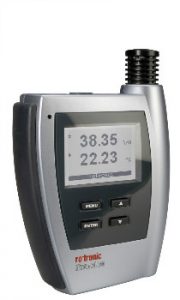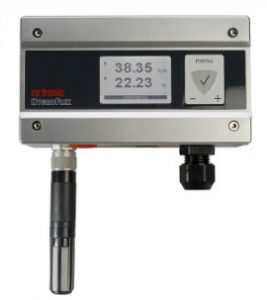Cheese Maturing and Humidity
Cheese Manufacturing in General
Since humans began to domesticate milk-producing animals around 1,000 BC, they have known about the propensity of milk to separate into curds and whey. It is the curds that are used to produce cheese.
Cheese Manufacturing Process
Cheese making involves a number of main stages which are common to most types of cheese.
Preparing the Cheese Milk:
Either pasteurized or non pasteurized cheese milk is used. Non pasteurized cheese milk contains the necessary bacteria to produce lactic acid, one of the agents that triggers curdling. Pasteurized cheese milk requires a culture of bacteria in order to produce this lactic acid.
If non-pasteurized cheese milk is used, the cheese must be ripened for at least 60 days at a temperature of not less than 4°C to ensure safety against pathogenic organisms.
Separating the Curds from the Whey:
 Animal or vegetal rennet is added to the cheese milk. The enzyme activity of the rennet causes the milk to coagulate: apparition of curd. The left over liquid is the whey.
Animal or vegetal rennet is added to the cheese milk. The enzyme activity of the rennet causes the milk to coagulate: apparition of curd. The left over liquid is the whey.
There are various ways to help accelerate the separation:
– Cutting the curd,
– Stirring the curd,
– Heating the curd.
The curd is finally put into molds and placed on draining boards. Once in the molds, the curd is then ready for pressing.
Aging the Cheese:
The cheese is deposited in a place of proper temperature and humidity to age. Some cheeses are aged for a Month, some for up to several years.
Why the Need to Measure the Relative Humidity?
Storage
For centuries, caves, which are usually cool and have a constant humidity, have provided a great environment to age and store cheese. Caves are still used today, Roquefort for example is a cheese aged in the natural Combalou caves in France. Nowadays, the storage area is a man made structure with a highly controlled environment.
The treatment during curd making and pressing determines the characteristics of the cheese. The actual flavor of the cheese is determined during the ripening of the cheese.
The ripening of the cheese is characterized first and foremost by the decomposition of protein. The degree of protein decomposition affects the quality of the cheese to a very considerable extent, most of all: consistency and taste.
The purpose of storage is to create the external conditions which are necessary to control the ripening cycle of the cheese as far as possible. For every type of cheese, a specific combination of temperature and relative humidity must be maintained in the different storage rooms during the various stages of ripening.
The climatic conditions are of great importance to the rate of ripening, loss of weight, rind formation and development of the surface flora: the total characteristic of the cheese!
The Optimum Conditions
Here are a Few Examples of Storage Conditions for a Few Cheeses:
Cheeses of the Cheddar Family: low temperatures: 4 to 8° C; Relative humidity lower than 80%. The cheese is often wrapped in plastic in order to prevent an excessive water loss. The ripening time may vary between a few Months up until 8 to 10 Months.
Cheeses like Emmentaler have a more complex maturing process: 3 to 4 weeks between 8 and 12°C followed by 6 to 7 weeks at 22 to 25°C. The final stage is several Months ripening between 8 and 12°C. The relative humidity remains between 85 and 90%.
 Semi-hard cheeses like Tilsiter or Havarti spend 2 weeks in a fermenting room at 14 to 16°C with a relative humidity of about 90%. During the fermenting process, the cheese is covered with a special cultured mix with a salt solution. After the 2 weeks, the cheese is transferred to the ripening room for another 3 weeks: 10 to 12°C and 90%rh. The final stage is storage in a cold room at 6 to 10°C at 70 to 75%rh.
Semi-hard cheeses like Tilsiter or Havarti spend 2 weeks in a fermenting room at 14 to 16°C with a relative humidity of about 90%. During the fermenting process, the cheese is covered with a special cultured mix with a salt solution. After the 2 weeks, the cheese is transferred to the ripening room for another 3 weeks: 10 to 12°C and 90%rh. The final stage is storage in a cold room at 6 to 10°C at 70 to 75%rh.
The last example is other hard and semi-hard cheeses like Gouda. These cheeses are stored at 10 to 12°C for a few weeks at 75%rh, then for a few weeks at 12 to 18°C and 80%rh. The last stage is a storage room at 10 to 12°C at 75%rh where the final characteristics are developed.
Air Conditioning:
During the maturing process, humidity needs to be removed from the cheese. This humidity will move from the cheese to the air (equilibration): the air in the chamber must not have humidity that is too high.
The air in the chamber is frequently renewed with air from outside which is typically warmer. As the temperatures are rather low during the ripening process, the air in the maturing chamber can hold less humidity than the air from outside. The air in the chamber will then be saturated and condensation will form, thus the need to dehumidify the incoming air.
What Solutions Can Rotronic Offer?
The measurement of relative humidity is not an easy task in the maturing chambers due to:
The relative humidity levels being high during the ripening process. On top of this, each cheese emits ammonia into the air.
Ammonia is a compound of nitrogen and hydrogen with the formula NH3. It is a color-less gas with a characteristic pungent odor. The result of the stress that both of these factors place on the humidity sensor is drift! The sensor will drift much faster than expected!
In order to maintain the perfect conditions in the chamber, Rotronic offers a range of products that will control air conditioning systems and a humidity sensor that is resistant to both the high humidity and ammonia!
Rotronic Products:
Humidity and Temperature Probes:
- HC2-S Standard humidity sensor, -50…100°C, 0…100%rh, ±0.8%rh and ±0.1K…
- HC2-S-HH Ammonia resistant humidity sensor, -50…100°C, 0…100%rh, ±0.8%rh and ±0.1K…
- HC2-IM Chrome nikel steel Industrial probe, -100…200°C, 0…100%rh, ±0.8%rh and ±0.1K…
Transmitters:
- HF5 series Fo
 r interchangeable probes, 2 or 3/4 wire configuration, Various analogue and digital outputs, Display, All psychrometic calculations available…
r interchangeable probes, 2 or 3/4 wire configuration, Various analogue and digital outputs, Display, All psychrometic calculations available… - HF7 series Stainless steel probe, -100…200°C, 3/4 wire configuration, Various analogue outputs, Display…
Dataloggers:
- HL-NT Range For interchangeable probes (up to 7 probes with docking station) 32MB flash card, Display, Conform to FDA21 CFR Part 11 and GAMP4…
- HL-20 20’000 measurement pairs, Display, ±0.8%rh and ±0.2K, Conform to FDA21 CFR Part 11 and GAMP4…
Customer Benefits:
Accuracy:
Choosing Rotronic gives you the best accuracy on the market. Precise humidity measurements can be obtained: meaning that as soon as the required relative humidity level is reached, the dehumidifier can be switched off.
How is this better for the maturing process?
The sooner the dehumidifier is switched off, the less power will be consumed. From the other side, as the humidity level is critical and defines the characteristics of the cheese, then the more accurate the measurement, the better the end result!
Communication:
With all of the different communication methods, from RS-485, Wireless to Ethernet RJ45, Rotronic can provide the solution for each installation.
Long Term Stability:
A long term stability with a drift under 1%rh per year (depending on the environment).
Calibration and Adjustment:
Calibration and adjustment is very easy with the Rotronic product range. As all of the communication is digital, the whole calibration procedure can be done via a PC, or directly from the device with the help of the Rotronic humidity standards. Rotronic can also offer a factory calibration (certified or not).
Source: Rotronic
